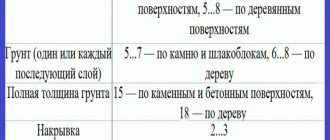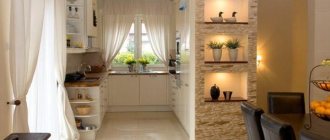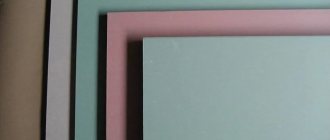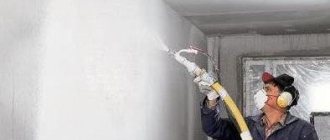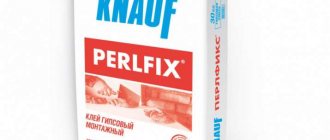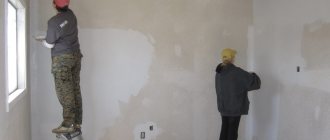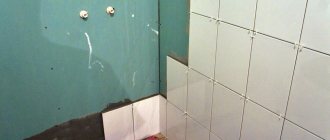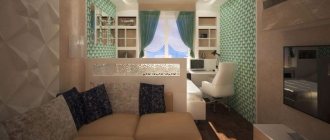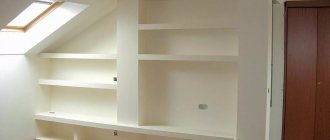In recent decades, along with the concept of “European-quality renovation”, a large number of new construction and finishing materials have entered our lives. One of them is plasterboard sheets. Despite its relative novelty, plasterboard for walls and ceilings has become not only very popular, but truly indispensable. The durability of a plasterboard wall depends on the correct choice of material and compliance with all technologies for installing gypsum plasterboard sheets on the wall. In this regard, it is necessary to take a closer look at what thickness of drywall is best for walls and how to attach it correctly to load-bearing surfaces.
Advantages and disadvantages of gypsum board sheets
Gypsum board (GKL) and their variety - gypsum fiber (GVL) sheets today occupy a leading position among wall finishing materials. Their great popularity is explained by a number of positive qualities that distinguish gypsum sheets from other interior finishing options.
- High technology and ease of installation. Do-it-yourself gypsum fiber board wall finishing is accessible even to non-professionals who have never done finishing work before. With its help, you can not only level the walls, but also bring to life the most daring interior design projects.
- Lightweight design. Due to the low mass of gypsum sheets, this design does not exert excessive pressure on the foundation and interfloor ceilings.
- Fire safety. Gypsum is a non-flammable material that can withstand open fire. In this regard, plasterboard finishing can be used to create fire-resistant partitions.
- Environmental friendliness of the material. Since gypsum plasterboard does not contain impurities harmful to humans, it can be used to cover walls in any residential premises, including bedrooms and children's rooms.
Among the disadvantages of this material are:
- Low strength. A wall covered with plaster cannot be used for hanging massive objects - bookshelves, wall cabinets, plasma panels, etc.
- Fear of dampness. Gypsum is highly hydrophobic and gets wet when exposed to moisture, losing its shape and rigidity. In this regard, GVL or gypsum board sheets cannot be used for external finishing work.
Due to the high hygroscopicity and poor resistance of gypsum to dampness, any gypsum board panels are intended exclusively for interior decoration. This even applies to so-called moisture-resistant plasterboard sheets.
Cons of drywall
There is no material that has only positive aspects, and drywall is no exception:
- if installed and handled incorrectly, fungus may develop in it;
- cannot withstand heavy loads;
- even moisture-resistant types of material become wet when in contact with water for a long time;
- Misalignments during installation can contribute to the appearance of cracks.
Design of a plasterboard partition in the bedroom
But all these shortcomings can be compensated for by using a certain technology in the construction of plasterboard partitions.
Types and technical characteristics
Modern industry produces several types of gypsum sheets. They all differ in their operational and technical characteristics. To choose the right drywall for a particular room, you should become more familiar with its properties.
GKL sheets
Purpose
- Standard drywall, also known as basic. It consists of a sheet of pressed gypsum, covered with cardboard on both sides, and is designated by the abbreviation GKL. The most common type of plasterboard sheet, widely used for finishing rooms with normal humidity levels.
- Moisture-resistant drywall (GKLV) is designed for use in rooms with high levels of humidity. The moisture-resistant sheet contains special water-repellent additives that reduce its hygroscopicity. In this regard, gypsum plasterboard sheets can be used for cladding bathrooms, toilets, and kitchens.
- Fire-resistant sheet - designation GKLO. Intended for finishing rooms with an increased risk of fire. Thanks to the treatment with fire retardants, such sheets are able to withstand the effects of open flames twice as long.
- Fire-moisture resistant plasterboard (GKLVO). It has a whole range of improved properties - it can be used in both wet and flammable areas. For example, it can be installed in kitchens with gas stoves.
Gypsum fiber sheet
Gypsum fiber sheets (GVL) are a special group of gypsum finishing material. GVL slabs are made from a mixture of gypsum and cellulose fibers in a ratio of 5 to 1. The distinctive quality of gypsum fiber sheets, compared to gypsum plasterboard, is their increased strength. Thanks to this, fairly heavy suspended structures can be attached to the wall.
One self-tapping screw screwed into a gypsum plasterboard wall can withstand up to 30 kg of load.
GVL can be installed either on a pre-assembled frame or directly on a leveled load-bearing base. In the first case, the GVL is attached to the wall using self-tapping screws, and in the second - using construction adhesives. GVL adhesive can be either silicone sealant or “liquid nails”, and sheets can also be attached to brick and concrete surfaces using cement- or polymer-based tile adhesive.
Dimensions
To more fully answer the question of which drywall is best to use in a particular case, special attention should be paid to the size of the sheet. Standard dimensions of drywall are presented in the table.
Dimensions of gypsum plaster boards from various manufacturers
To optimize material costs, it is advisable to select the size of the plasterboard sheet that is a multiple of the length and width of the surface to be sheathed. In this case, the amount of non-target waste will be minimized.
Sheet thickness
One of the most important indicators is the thickness of the plasterboard sheet - the scope of its application and installation technology depend on this. The modern market of finishing materials offers the widest selection of gypsum sheets: their minimum thickness is 6 mm, maximum – up to 50 mm. The first, thinnest material, is intended for covering surfaces with low external loads - for example, ceilings.
Also, the thin sheet is excellent for the manufacture of various decorative elements of interior design - arches, niches, curved structures. This is due to its low rigidity and ability to bend to the desired shape.
Decorative arched structure made of gypsum plasterboard
The most massive gypsum boards up to 5 cm thick are used to level floors as a basis for finishing floor coverings that require a perfectly flat surface: laminate, linoleum, parquet. The thickness of the plasterboard for the wall is selected depending on its functional purpose.
In rooms with an increased likelihood of mechanical impact on the walls (hallways, staircases, children's rooms), it is advisable to use thicker sheets. For decorative finishing of the interiors of living rooms or bedrooms, you can use thinner varieties of plasterboard.
The most popular thickness of gypsum plasterboard for walls is 12…15 mm, which allows for the most optimal use of the material. Such a sheet is able to withstand significant physical loads, shocks and pressure, while it does not weigh down the wall structure and has a low cost.
To improve the resistance of wall plasterboard to external loads, various structural solutions are also used when installing partitions. According to the provisions of SNiP, the following types of partitions made of gypsum plasterboard or gypsum fiber board are used in construction.
S-111
Single-layer wall type C-111
This design consists of a single frame sheathed in one layer on both sides with plasterboard sheets. The inside of the wall can be filled with insulation or sound-proofing materials, most often mineral wool or expanded polystyrene. The thickness of such a wall depends on the width of the frame profile and the thickness of the gypsum board sheets used. Weight 1 cu. m of wall S-111 is about 25 - 30 kg.
S-112
It is a wall made of a single metal frame and two-layer sheathing on each side. This design has increased sound insulation properties of up to 50 decibels. In addition, it is often used to create fireproof screens to isolate potentially flammable rooms. In this case, the frame is filled with non-combustible material and sheathed with fire-resistant sheets. Weight of 1 cubic meter – from 50 to 55 kg.
S-113
This wall is intended for use in finishing rooms with high humidity. It has a single frame and is sheathed with a triple layer of moisture-resistant plasterboard. To improve thermal insulation and sound absorption, drywall can be used in combination with mineral wool filler. The mass of m3 of wall is about 75 kg.
S-115
To create the S-115 wall, a double frame is used, sheathed with two layers of gypsum board. This increases the strength of the partition, and, depending on the brand of plasterboard sheet used, increases fire or moisture resistance. As an option for wall C-115, each layer of the double frame can be separated from each other by an additional sheet of plasterboard. The mass of such a wall ranges from 55 to 70 kg/m3.
S-116
Such a wall is structurally similar to type C-115, but unlike it, it has space inside for laying communications - electrical wiring, pipelines, ventilation ducts. The thickness of the S-116 wall largely depends on the dimensions of the communication lines. The weight of a cubic meter of S-116 can be up to 60-65 kg, the noise absorption rate can be up to 50 decibels, and the resistance to open fire in the gypsum plasterboard version is about 1.5 hours.
S-118
A wall with a higher class of resistance to mechanical stress, designed to prevent unauthorized entry into the room. It consists of a single frame, similar to walls S-111...S-113, sheathed with three layers of gypsum plasterboard. To enhance strength, a sheet of galvanized steel is inserted between each layer of drywall. At the same time, this increases the wall’s resistance to open flame and moisture.
The video below shows the procedure for installing a plasterboard partition with your own hands.
Having familiarized yourself with the main operational and technical characteristics of gypsum plasterboard sheets, you can imagine which drywall is best to use in a particular case. Also, based on the purpose of the room, you can choose the most suitable type of wall construction.
Rating of materials for the construction of partitions: our version
Based on the analysis, we have compiled our rating of materials for indoor premises. In our opinion, due to its simplicity, speed of construction, low price and durability, plasterboard is the leader in this list. If you add to its installation the possibility of installing it in a double way (sheet on sheet), laying insulation, waterproofing, then this leadership is strengthened even more.
We shared second place between GVL and PGP. Each of the materials has its own subtleties. However, there are technological solutions that allow you to quickly and effectively eliminate any nuances. If you take into account the peculiarities of the operation of partitions at the construction stage, then subsequently you will not have any problems with the walls for decades.
The item with the gas block closes our list. The main advantage of this material is the price. Construction using aerated concrete blocks will cost an order of magnitude cheaper than using the same PGP and GVL. In the hands of professional builders, the walls will be very durable. For apartments and private houses it is also a completely acceptable option.
In the summary table we provide information about the main characteristics of materials for the construction of partitions.
| Parameter | GKL / GKLV / GKLO (12.5mm) | PGP Gypsum (80 mm) | GVL (12.5 mm) | Aerated concrete block (100 mm) |
| Density, kg/m3 | 750-800 | from 1000 | 1200 | 400-600 |
| Acoustic noise insulation index, with a standard Rw of 45 dB | from 30 | 45-48 | from 33 | 39 |
| Tensile strength, MPa | from 3.5 | from 5 | from 5.3 | about 3.5-4.5 (according to classes B2.5-B3.5) |
| Water absorption,% | to 10 | up to 5 | until 3 | 47,5% |
